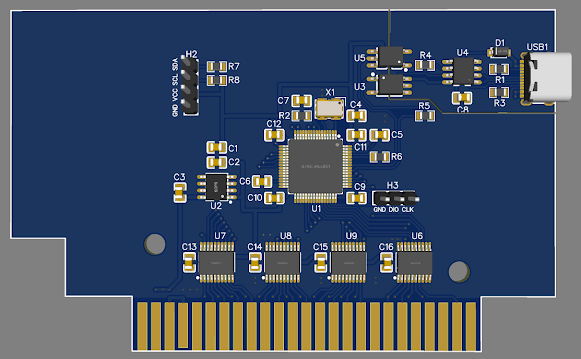So, does this cartridge work now?
Well, no, it still doesn't work.
Here's a recap of the situation:
I first developed a cartridge version using Chinese-origin RISC V processors. The goal of this cartridge was to enable the downloading of MSX executable files directly into FLASH from any PC, which could later be executed by the MSX computer.
 | |||
| RISC-V prototype with one processor |
 |
| RISC-V prototype with two processors |
 |
| RISC-V prototype plus HF port for MSX reset |
While my developments were successful on the MSX machine I had, it turned out that I encountered various problems on other people's MSX computers. So, I opted for a faster processor, the STM32F525 type. I also fixed several issues during this new development phase.
 |
| ARM STM32 processor |
Everything was working very well, until I tried to start my MSX computer with this new cartridge. And this time, I never managed to get anything to boot. After thorough investigation, I finally determined that the issue is simply that this STM32 processor is not capable of changing its input/output pins state quickly enough to serve the MSX computer.
I could have tried to use more suitable peripherals, such as the external memory management systems available on STM32s, but that requires twisting your mind more than reasonably necessary, without having any visibility on the outcome.
It's not about mastering the bus like reading from or writing to external memory, or generating a video image. No, here it's about behaving as a slave and serving data with strict timing.
So I thought about Raspberry products, specifically the RP2350 microcontrollers. This component seemed better suited than the microcontrollers used up until now. So, I installed the development solution based on the Visual Studio Code editor, plus the Raspberry toolchain.
Alas, as soon as I opened Microsoft's editor, buttons of all kinds sprouted all over my face. I found, with just as much detestation, the installation examples that are never updated and don't match the situation, and especially the various and sundry messages from Visual Studio Code that mean nothing regarding the problems encountered – except for those who were bottle-fed this crap from earliest childhood at university.
In short, the whole "it should work, but who knows anyway, he clicks, he clicks, he'll get there, and if he doesn't, he's an idiot and we don't care!" attitude.
Anyway, I uninstalled all that crap faster than the installation took.
There are also ESP boards, but the DIY/hacky aspect of the subject today acts as an absolute repellent for me.
So? Well, if I consider that the only viable solution for connecting memory to the MSX bus is to use good old-fashioned logic, then I'm going to try using a small FPGA, actually condense my first idea into an FPGA to facilitate PCB routing rather than doing it like on my very first cartridge prototype :
 |
| The very first prototype but not with the right use of USB |
Here again, the solution isn't simple either. There are FPGAs of all kinds, but most are unsuitable for my needs. So I fell back on Efinix FPGAs. And there, I'm venturing into the unknown once again.
Indeed, a few months ago, I tried to implement a Z80 system in a TRION FPGA for my attempt to create a new Drumulator, but without success. I had therefore decided to go with another hardware solution, even if it meant reprogramming the Drumulator's software. I actually developed the audio part of the Drumulator with an STM32 microcontroller. I did this development with EasyEDA PRO, and I must say that thing is a real nightmare. Buggy everywhere. I wonder what it will be like in a few months, since EasyEDA has decided to stop developing the standard version in favor of the Pro version. So, discontinuing a functional version to force users onto a buggy one: hmm...
As a result, I redeveloped the analog part of the Drumulator with KiCad.
But, to get back to the MSX cartridge, Efinix FPGAs have all the desired features, plus at a reasonable price. But, and there's always a but, I also need to implement a small processor on the cartridge to manage the transfer from the PC.
And there, I made a decision that I hope won't lead me to a dead end, which is to use the soft-core RISC processor provided by Efinix.
So for now, I've contented myself with creating the inevitable 'Hello World' for electronics engineers: making an LED blink, but not through logic wired inside the FPGA, but rather via the Sapphire processor implemented within it. Everything is ready for the first tests.
However, since the internal processor also needs to be programmed via JTAG, it's not possible to share the JTAG port already integrated on the development board, which is used for programming the FPGA. Therefore, this other JTAG port needs to be managed with suitable hardware, in this case, an FTDI cable that offers the JTAG protocol. I've ordered one.
I can attempt to make an LED blink as soon as I receive it.
I must admit that my developments over the last few months, or even for almost two years now, have yielded nothing truly conclusive. My latest achievement remains my TMS1122-compatible (UTC 1122) digital clock, which I had to complete in 2023. It works wonderfully. You can find the description of this clock on this blog... somewhere in 2023, I think.
It's high time that all the experience accumulated over these past two years finally leads to something concrete!
Is it me getting really old, or is the completely idiotic atmosphere prevailing in France and Europe finally getting to me? Probably a bit of both.














